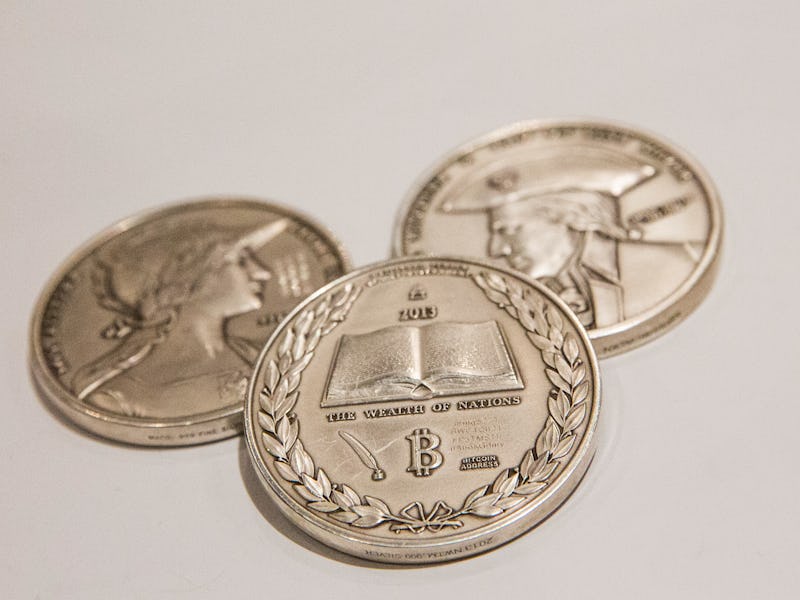Buy Bitcoin in 3 Steps, Without Getting Ripped Off
The simplest approach is still the most secure one.

So, you want to buy some bitcoins. It’s natural, what with the currency surging to all-new highs, and some analysts even predicting a climb to astronomical values like $10,000 by the end of this year. There’s a problem, though: even today, after all the development of bitcoin and cryptocurrencies, bitcoin really is not very easy to buy.
There are various reasons for this, chief among them that many banks don’t particularly want it to be easy for the average person to buy bitcoin, but in recent years the options have greatly expanded. We look at the three basic steps to buying bitcoin, and the variety of options that exist for each in the modern era.
1. Get a Wallet
The first decision to make when purchasing bitcoin is what sort of “wallet” will be used to store those bitcoins once they’re purchased. It can be intimidating. There are many competing services and devices, but they are all basically bank accounts that can store encrypted references to currency on the bitcoin blockchain. The only thing that it’s really important to know about the blockchain is that it keeps each coin-ID totally unique and impervious to tampering. So, bitcoins might be naught but data, but a wallet actually does hold them much like a physical wallet. If the data gets corrupted or lost, that value is as gone as if you set a paper bill on fire.
So, the choice of wallet is important. There are online wallet services, often called “hot wallets,” as well as physical options ranging from specially protected drives like Ledger, to storage on the hard drive of a desktop computer. It really comes down to what you want to do with bitcoin. If you’re going to buy a lot of small items in the real world, you’ll probably want a hot wallet that offers a convenient mobile app for quick withdrawals. If you’re buying bitcoin as a long-term investment, you probably need an option with fewer features and thus fewer possible security holes. In general, physical storage on a non-internet-connected device is considered the safest form of wallet — but also the least user-friendly, and the easiest to physically lose.
2. Choose a Bitcoin Exchange (or Seller)
Again, the approach here should vary depending on what you want out of bitcoin. With so much interest in cryptocurrencies these days, there are extremely convenient options out there, like the option to buy bitcoin via mobile app and have the cost charged directly to your cell phone bill. This isn’t necessarily “insecure,” since the connections are always highly encrypted, but the number of interacting companies and services involved definitely makes these options the least secure. They also lock the purchase to your real-world identity more powerfully than other methods.
On the other hand, there are many, more conventional currency exchanges offering a wide variety of options — and a wide variety of fees. Some exchanges, like Virwox, require very little information upon purchase, but they also take a larger cut of each transfer than their competitors. Coinbase is an extremely user-friendly option for beginners, and bitstamp is highly thought of, as well.
These options allow bitcoin purchases by bank account, credit card, and PayPal, but as always, the most secure method is to find an individual who’s looking to sell their bitcoin for the currency you have. That way involves the fewest fees and the smallest paper trail, but it’s also the hardest to put together in the real world.
3. Quickly Store Your Bitcoin in Your Wallet
In general, it’s not advisable to leave your newly acquired bitcoin in the exchange itself, simply associated with your user account, because exchanges can be notoriously unreliable. As soon as you can, find the option to transfer currency in the exchange’s control panel, and send your entire fortune to whatever wallet you selected.
Now comes the hardest part of all: what do with them? You can hold on to it as a bet on the future of bitcoin itself, but assuming you bought bitcoins to use them, the ideal case is that you can find someone who’s got something you want, and who wants bitcoins in exchange. That simple person-to-person transfer requires the minimum of outside contact or supervision, and carries no extra fees. On the other end of the spectrum, there are services that allow users to pay for Amazon purchases with bitcoin.
The options are expanding, both before and after a bitcoin purchase. If you’re looking to get into the bitcoin game, there’s never been an easier or more secure time to do it.